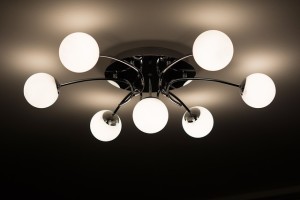 If you’re one of the many Scottsdale homeowners slowly making the switch to LED light bulbs, you probably have several questions about how they work, what makes them special, and why they’re being touted as the gold standard in lighting.
If you’re one of the many Scottsdale homeowners slowly making the switch to LED light bulbs, you probably have several questions about how they work, what makes them special, and why they’re being touted as the gold standard in lighting.
At their core, LED light bulbs still do the same thing as any other light bulb: generate light. There are, however, a number of notable differences to take note of before making your purchase. In this guide, we go over a few of the most basic factors to consider before purchasing LEDs for your Scottsdale home.
Think Lumens, Not Watts
Many of us are used to equating watts for brightness; essentially, the more watts a bulb needs, the brighter it is. And this rudimentary measure of illumination worked when evaluating incandescent bulbs, halogens, and to some extent, compact fluorescent lamps (CFL).
But with your typical LED requiring only a fraction of the electricity (i.e. watts) needed by an incandescent bulb, wattage is no longer a reliable indicator of brightness. Add in the fact that different makers of LEDs often have varying power specifications for their LEDs; brand X and brand Y can generate the same intensity of light but at different electricity ratings.
Instead, the more reliable way to determine an LED’s brightness is its lumens rating—a lumen is the actual unit of a light source’s brightness.
To give you an idea of what to look for, a-100 watt incandescent bulb usually generates about 1600 lumens. If you want an LED counterpart, look for a device with the same lumens rating—you’ll find that it only needs around 10 to 15 watts of power.
Mind the Color Temperature
LEDs come in different colors, but your main choices are warm and cool.
Warm LEDs give off a relaxing, yellowish glow, which is perfect for dining rooms, living rooms, bedrooms, and anywhere else you’d want to have a relaxing feel. On the other hand, cool LEDs give off a bluish-white light, is ideal for areas in the house where you’d want to feel awake and productive, such as the kitchen, office, and garage.
In this case, the issue isn’t so much about brightness as it is about lighting quality. Confused? Here’s a great guide on color temperature and how to choose LED colors according to their intended application.
Look for Extra Features
Unlike conventional bulbs, some LEDs offer features that give your home lighting system added depth in terms of functionality. For starters, there are LED bulbs that can be dimmed without having to install a knob on the main switch.
These Smart LEDs can connect to your smartphone via wireless network, allowing you to control their brightness and color. You can even create schedules to automate your home lighting, making sure they come on and off at specific times of the day—a useful security feature when you’re away from home for several days.
Higher Upfront Costs
If you’re new to LEDs, don’t be surprised if they cost twice, thrice, even four times as much as conventional bulbs. However, it’s important to note that while LEDs do indeed have a higher initial cost, investing in LED lighting ultimately pays off for itself in the long run.
LEDs are so energy-efficient their energy-sipping abilities translate to a noticeable reduction in your utility bill. And after just a few months, your investment will have paid off from the energy savings alone.
So the next time you go shopping for LED bulbs, keep these four tips in mind to make an informed purchase decision.


 Apartment Lighting
Apartment Lighting Area Lighting
Area Lighting Automotive Lighting
Automotive Lighting Building Wall Pack Lighting
Building Wall Pack Lighting Canopy Lighting
Canopy Lighting High & Low Bay Lighting
High & Low Bay Lighting Industrial Lighting
Industrial Lighting Parking Lots & Garages
Parking Lots & Garages Pathway Lighting
Pathway Lighting Retail Lighting
Retail Lighting Stairwell Lighting
Stairwell Lighting























